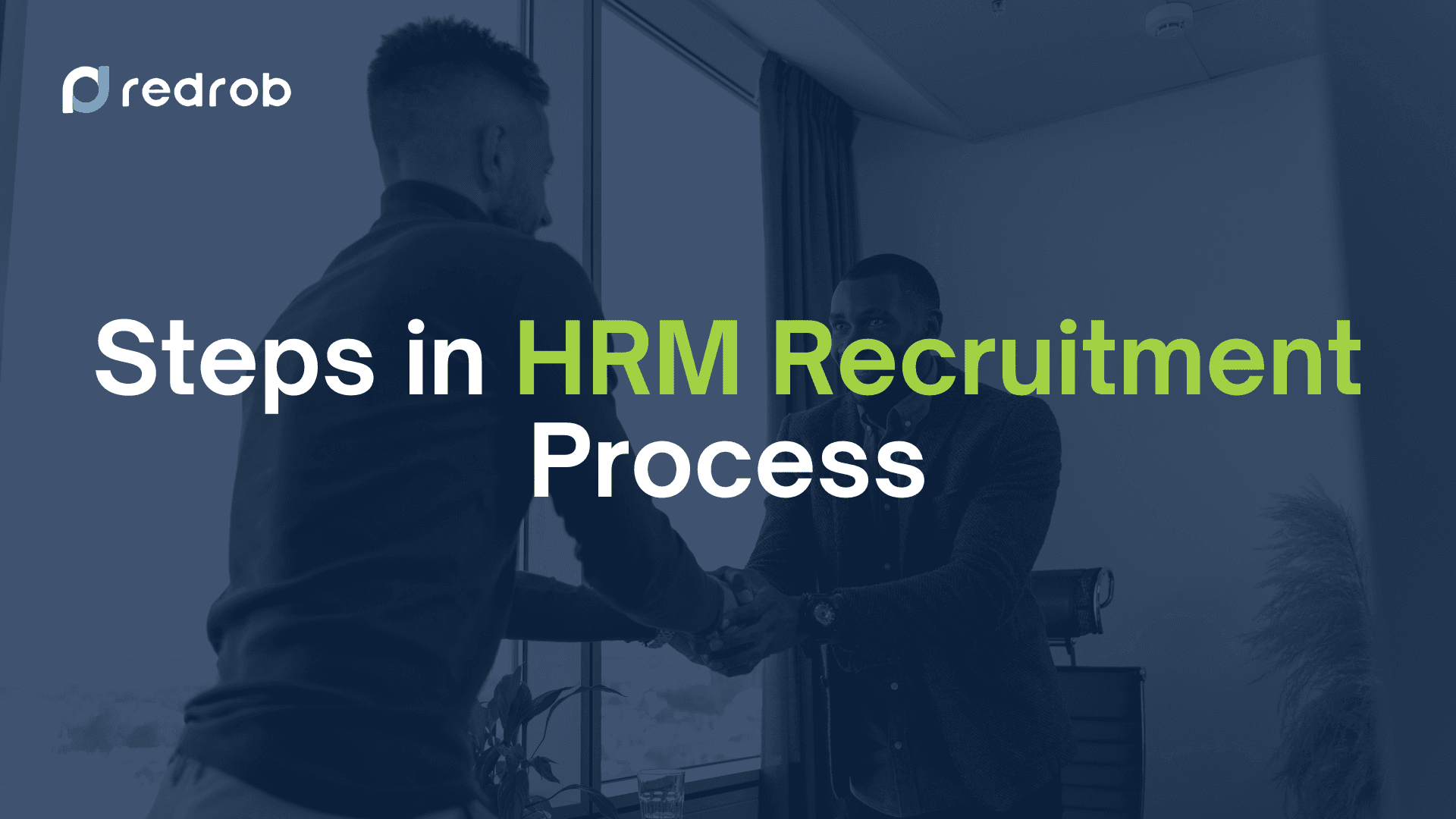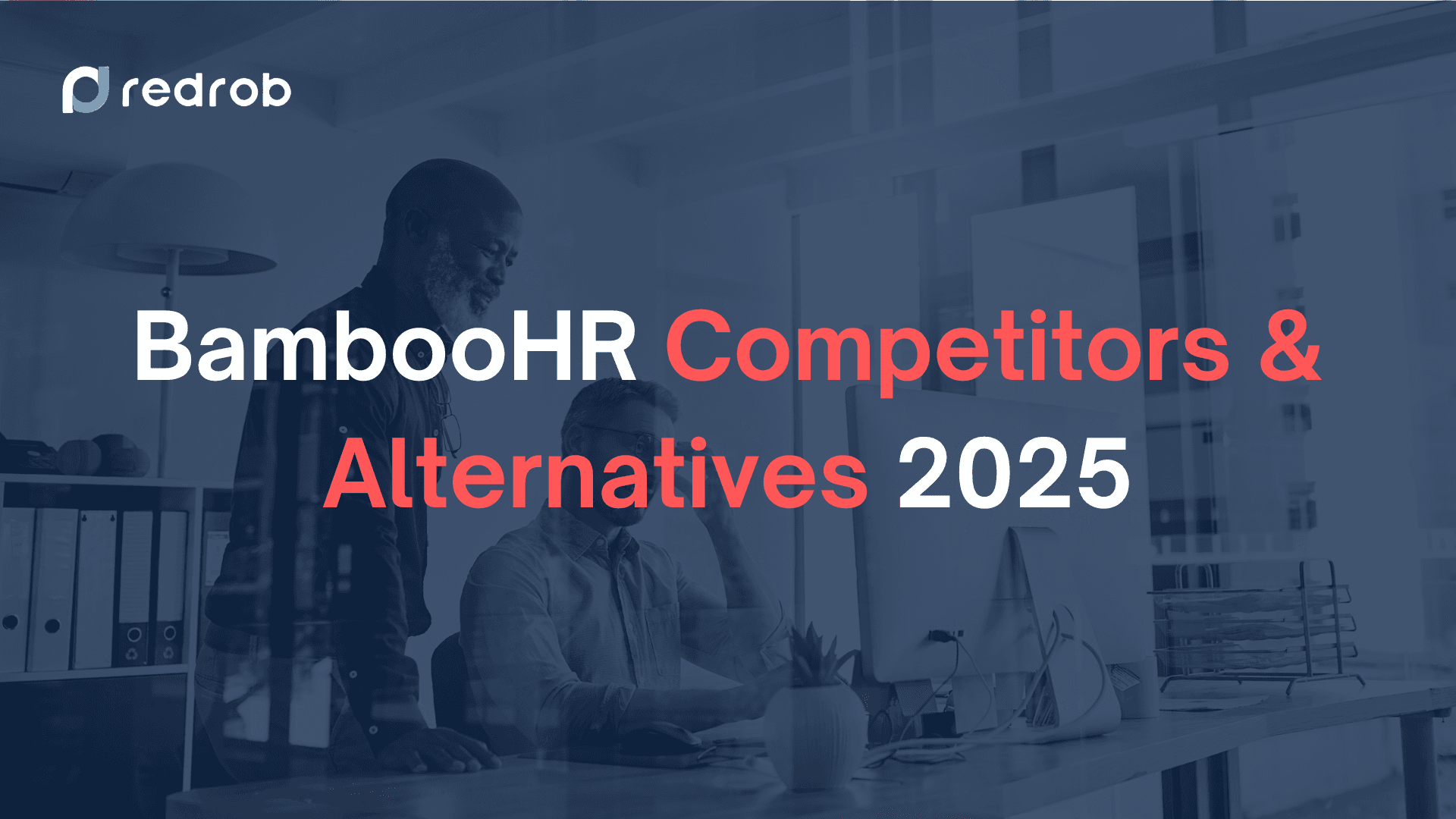HRM Recruitment Process
12 min read
•
Oct 4, 2024

Soumyata Singh
All experienced HR professionals here know very well that reliable hiring decisions come from a well-organized recruitment process. When you follow the recruitment process correctly, more than half of the things are done right. A step-by-step process paves the way for onboarding valuable talents and preserving them as a team.
Each step helps you attract and retain qualified candidates. By understanding and following these steps, you improve the quality of your hires. This structured approach also streamlines the process, saving time and resources. In this blog, you'll explore each of the recruitment process steps in HRM (Human Resource Management) and learn how to implement them effectively in your organization.
Recruitment Process In HRM (Step-by-Step Guide)
Here’s a detailed description of the recruitment process steps in HRM:
1. Job Analysis and Job Design
Before you begin recruiting, it’s important that you understand the specific needs of a position. Job analysis and design are therefore crucial aspects of the recruitment process steps in HRM. They help you define job responsibilities and qualifications, ensuring that you target the right candidates. A well-structured job design leads to better hires and improved retention.
Define Job Duties, Skills, and Qualifications
The first step is identifying what the role requires. You must clearly outline the job duties, skills, and qualifications. Start by assessing what tasks the employee will perform daily. For example, if you're hiring a software developer, their main duties may include coding, debugging, and collaborating with team members.
Skills are just as important. Make sure you list both hard and soft skills. In the case of a software developer, proficiency in programming languages like Java or Python is critical. However, soft skills like problem-solving and teamwork are also essential.
Qualifications such as education and experience also shape the ideal candidate profile. You might require a bachelor's degree in computer science and at least three years of experience for the software developer role. Clearly mentioning these details makes it easier for candidates to understand your expectations.
Create Comprehensive Job Descriptions
Once job duties and qualifications are clear, the next step is creating a comprehensive job description. This document should provide a clear overview of the role, responsibilities, and expectations. It's not just about attracting talent; it's about attracting the right talent.
Make sure the job description includes the job title, key responsibilities, required qualifications, and any additional information, like work hours or location. For example, in the software developer job description, you might specify responsibilities like “Develop new software applications,” along with required qualifications such as “Proficient in JavaScript.”
A strong job description gives candidates a clear picture of the role, reducing the chances of receiving irrelevant applications.
After defining the job, it's essential to assess whether you need to fill a position. This involves analyzing your organization's current staffing needs and future growth. Let’s get the details in the next step of the recruitment process.
2. Identifying Hiring Needs
Before beginning the recruitment process, you need to identify your hiring needs. Understanding gaps in your workforce ensures you bring in the right talent. A clear identification of these needs is an important one in the recruitment process steps in HRM.
Analyze Vacancies
Start by analyzing current vacancies. Ask yourself: Why is this position open? Is it due to employee turnover, expansion, or restructuring? Understanding why specific positions are vacant helps you decide whether they need to be filled or can be restructured.
For example:
If an employee resigned, consider if their role is still necessary or can be merged with another.
If you're expanding, analyze how the new role fits into your company’s growth plans.
Determine Job Specifications
Once you've identified a vacancy, determine the job specifications. These are the requirements, skills, and qualifications needed for the role. This step ensures you target the right candidates.
Consider the following:
What qualifications are non-negotiable?
What skills can be learned on the job?
For example, a Data Analyst may require a strong background in statistics and proficiency in Python, but the ability to work with specific company software could be taught.
Conduct Gap Analysis
Gap analysis helps you assess the skills currently available in your team versus what’s required. This analysis ensures you're not just filling roles but addressing long-term business needs. For instance, if your team is missing digital marketing expertise, hiring someone with strong online marketing skills would bridge that gap.
Track Input vs. Output
To further refine your hiring needs, track the input vs. output ratio of your workforce. Are you getting the expected results based on the current team size and skill set? If not, you may need to recruit additional talent or upgrade your team's capabilities. This data-driven approach is an important element in the recruitment process steps in HRM, helping you assess productivity gaps.
Performance Analysis
Conduct regular performance analysis to identify areas for improvement. If your team is underperforming in key areas, it may signal a need for new hires. High performers bring value, but underperformers may indicate misalignment in current job roles. By analyzing these trends, you can pinpoint the type of candidate that will enhance performance and productivity. For example, if a sales team consistently misses targets, hiring a specialist in customer relationship management may be the solution.
Monitoring Employee Turnover Rates
High employee turnover can indicate dissatisfaction or misalignment within your company. Regularly monitoring turnover rates helps identify potential hiring needs. If turnover is high, consider recruiting candidates who better fit the company culture and long-term goals. The average employee turnover rate in India is 18.3% as of 2023. If your turnover exceeds this, it may be time to adjust your hiring strategy.
Once you've identified your hiring needs, it's time to explore where and how to find the best talent in the next step.
3. Sourcing Candidates

Once you’ve identified your hiring needs, the next step is sourcing candidates. The recruitment process steps in HRM require you to explore both internal and external sources. You can explore both internal and external sources to fill vacancies effectively. Choosing the right method ensures you attract candidates who are a good fit for the role.
Internal Sources
Start by considering internal sources. It’s a cost-effective and efficient way to fill roles since internal candidates are already familiar with your company culture.
Transfers: Move an employee from one department to another where their skills are needed. This can be an efficient way to fill positions. Internal candidates already know the company culture, which reduces onboarding time.
Promotions: Reward high-performing employees by promoting them to higher roles. Promotions boost morale, as employees see growth opportunities within the company.
Existing Employees: Consider part-time workers or contract employees for full-time positions. Reviewing employee performance regularly helps you spot potential candidates for internal promotions or transfers.
For example, if a project manager leaves, you could promote a team lead from within, saving time on training and onboarding.
External Sources
External sources expand your talent pool, giving you access to a wider range of candidates.
Job Postings: Post open positions on popular job boards like Indeed, LinkedIn, or specialized platforms.
Recruitment Agencies: Agencies can help you find pre-vetted candidates quickly.
College Recruiting: Partnering with universities gives you access to fresh graduates with up-to-date skills.
Job Fairs: Consider college recruiting to tap into fresh talent. Many companies attend job fairs to connect with candidates face-to-face, making a strong impression.
According to LinkedIn, 60% of professionals consider job boards to be one of the top sources for finding jobs.
Use Professional Networking Sites and Social Media
Professional networking sites like LinkedIn allow you to reach passive candidates who may not be actively job searching. You can use these platforms to post jobs, share company updates, and engage with potential candidates.
LinkedIn: Use LinkedIn to search for candidates based on skills, location, or industry. Engage with passive candidates by building relationships.
Social media: Platforms like Twitter, Facebook, and Instagram can also be used to promote job openings and interact with potential talent.
With Redrob, you get access to the top 10% talent pool. Now you can easily make clear and comprehensive job posts and manage applications better than ever.
Make your first FREE job post now!
After sourcing candidates, the next step involves screening them. Let’s explore it in detail.
4. Screening Candidates
This step is critical in narrowing down applicants and ensuring the best fit. Effective screening within the recruitment process steps in HRM helps save time and resources while focusing on quality candidates.
Review Resumes and Cover Letters
Begin by reviewing resumes and cover letters. Look for candidates whose experience, skills, and qualifications match the job description. Pay attention to how well the cover letter is tailored to the position. Studies show that recruiters spend an average of 7.4 seconds scanning a resume. This means clarity and relevance are crucial. Reviewing these documents carefully is a crucial step in filtering out unqualified applicants.
Identifying Qualified Candidates
Once you’ve reviewed the documents, it’s time to identify qualified candidates. Create a shortlist of individuals who meet the job specifications. You can use checklists to compare each resume against the required skills and qualifications. Identifying the right candidates early streamlines the recruitment process steps in HRM, allowing you to focus on top talent.
Pre-Screening Tools
Pre-screening tools can further refine your candidate pool. These tools often include online assessments or questionnaires that evaluate technical skills, personality traits, or cultural fit. They help eliminate candidates who may look good on paper but don’t have the required skills.
In-Depth Reviews and Phone Screenings
After pre-screening, conduct in-depth reviews of the shortlisted candidates. This could involve checking work samples or evaluating project portfolios. Follow this with phone screenings to assess communication skills, availability, and salary expectations. Phone screenings are an efficient way to gather important information before scheduling more time-intensive interviews.
Redrob’s excellent ATS (Applicant Tracking System) lets you centralize the recruitment process and get updates about each applicant’s journey within the pipeline. It reduces applicant screening time by 60%. Explore more about our ATS.
After narrowing down your list through screening, the next step is conducting interviews. Let’s see how to handle interviews effectively in the following section.
5. Conducting Interviews

After screening, the next step is conducting interviews. This part of the recruitment process steps in HRM helps you evaluate a candidate’s potential more closely. Interviews allow you to assess not just skills but also cultural fit and attitude.
Methods of Conducting Interviews
Interviews can be conducted in various ways, each offering unique advantages.
Phone interviews: These are quick, cost-effective, and help filter candidates early in the process.
In-person interviews: Ideal for evaluating body language, personality, and overall fit within the workplace.
Video conferencing: This method offers flexibility for remote candidates while maintaining a personal touch.
For instance, a phone interview may work well as a first step, followed by an in-person interview for local candidates or a video conference for remote applicants. Many employers now use video interviews during the hiring process.
Use Structured Interview Formats
Using structured interviews is crucial to maintain consistency. You ask each candidate the same set of questions, ensuring fair comparison. Structured interviews lead to better hiring decisions and reduce bias. Several sources say that structured interviews are twice as effective at predicting job success compared to unstructured ones. By standardizing your approach, you align with best practices in the recruitment process steps in HRM.
Include Behavioral and Situational Questions
Behavioral and situational questions help you assess how candidates handle real-life situations. For example, you can ask a candidate, “Tell me about a time you had to meet a tight deadline.” This approach gives insight into their past actions and future performance. Behavioral questions are highly effective and many hiring managers ask these to predict future behavior based on past experiences.
Once interviews are completed, it’s time to assess each candidate’s fit for the role. Let's explore how to evaluate candidate suitability in the next section.
6. Assessing Candidate Fit
After interviews, assessing candidate fit is a necessary part of the recruitment process steps in HRM. It involves evaluating skills, verifying backgrounds, and understanding personality traits. This ensures you select a candidate who aligns with the role and company culture.
Skills Tests
Skills tests give you a clear picture of a candidate’s abilities. These tests can be technical, such as coding challenges for IT roles, or practical, like writing samples for content positions. 60% of companies use skills tests to determine a candidate’s capabilities before making a decision. These tests are objective and help you focus on real performance, not just what’s on a resume. With Redrob’s recruiting package, you get 3500+ customizable skill assessment tests to make sure you pick the right candidates.
Reference Checks
Reference checks allow you to verify a candidate’s past performance. Contacting previous employers provides insight into work habits, reliability, and character. Reference checks are an important safeguard in the recruitment process steps in HRM. For example, you can ask about the candidate’s ability to meet deadlines or work in teams.
Background Screenings
Background screenings ensure there are no red flags in a candidate’s history. These checks include criminal records, employment verification, and educational credentials. Around 60% of employers conduct some form of background screening. It helps ensure that the candidate has been truthful and meets your company’s security standards.
Psychometric Testing
Psychometric testing is another way to assess candidate fit. Aptitude tests evaluate problem-solving skills, while personality assessments help gauge a candidate’s cultural fit. These tests help you understand how a person will behave in various work scenarios.
After thoroughly assessing candidates, the next step is extending an offer. Let’s move on to it.
7. Making a Job Offer

After assessing candidates, the next step in the recruitment process steps in HRM is making a job offer. This step seals the deal and brings the chosen candidate on board. A well-crafted offer can ensure the candidate accepts and commits to the role.
Offer Employment to the Chosen Candidate
Once you've selected the top candidate, it’s time to extend the job offer. Contact the candidate and communicate the details of the offer clearly. Include salary, benefits, and job responsibilities. To make sure you’re clear, consider using the best offer letter templates available online. Be prepared to answer any questions the candidate may have. Job seekers are more likely to accept a job if the offer is detailed and competitive. Ensuring transparency at this stage helps avoid misunderstandings later.
Finalize the Hiring Process
After the candidate accepts the offer, finalize the hiring process. This includes completing any necessary paperwork, such as employment contracts and tax forms. Confirm the start date and outline the next steps, such as onboarding or orientation. A smooth and organized conclusion to the recruitment process steps in HRM sets a positive tone for the candidate’s first day.
When the offer is accepted, it’s time to introduce the new hire to your company. Let’s explore how to effectively onboard new employees in the next section.
8. Onboarding
Once the candidate accepts the offer, it’s time to start the onboarding process. Onboarding is a crucial step in the recruitment process steps in HRM. A smooth and well-organized onboarding helps new hires adjust quickly and feel welcomed.
Join New Hires into the Organization
Joining new hires into the organization is your first priority. This involves introducing them to the company culture and ensuring they feel like part of the team. Make the transition seamless to give your new employees a strong start.
Complete Necessary Paperwork
Next, complete all necessary paperwork. This includes employment contracts, tax forms, and benefits enrollment. Getting this step done quickly prevents delays and helps the new hire focus on their role. Using digital systems for paperwork can speed up this process and ensure accuracy.
Providing Orientation and Training
Orientation and training are essential parts of onboarding. The new hire needs to understand their job duties and how the company operates. Conducting a thorough orientation helps set expectations and provides clarity. Training programs can range from job-specific skills to broader company policies.
Introducing New Hires to the Team
Introducing new hires to the team helps them feel included right away. Arrange meet-and-greet sessions or informal team lunches. When new hires build relationships early, they are more likely to feel comfortable in their role. This step in the recruitment process steps in HRM enhances teamwork and collaboration.
Assigning Mentors or Buddies
Assigning mentors or buddies is another way to support new hires. A mentor or buddy can answer questions, offer guidance, and help the new employee adjust. Research shows that 56% of new hires with a buddy program are more likely to be productive faster. This step helps reduce the anxiety of joining a new workplace and boosts confidence.
With the onboarding complete, your recruitment process comes full circle. Each step, from sourcing to onboarding, plays an important role in attracting and retaining top talent.
Streamline Your Recruitment Pipeline With Redrob
The recruitment process steps in HRM are crucial for building a strong team. You start with job analysis and design, identifying hiring needs, and sourcing candidates. Then, you screen candidates, conduct interviews, and assess their fit. Finally, you make a job offer and onboard new hires. Each step helps you attract the right talent and ensure a smooth hiring experience.
By carefully managing each step, you increase your chances of finding the best candidates. A well-executed process also boosts employee retention. When you assess fit properly, you hire people who align with your organization’s goals and culture. This improves job satisfaction and reduces turnover, saving you time and resources.
Recruitment tools like Redrob make all this even better and easier for you. Redrob’s complete suite of recruitment solutions help you make data-driven decisions, centralize and automate tasks, track applicant status, assess them on different levels, and a lot more.



